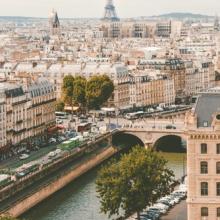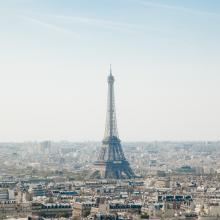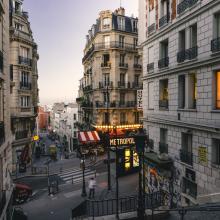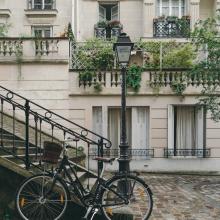Description
For a detailed program description, please visit the comparative literature Department website:
https://complit.washington.edu/study-abroad/fall-quarter-paris
Program Description
When Baron Haussmann reconstructed Paris into the “City of Light” (1852-1870), he produced an urban space that came to represent the Western world's break with tradition and the emergence of modernity. Modernism, the characteristic style of cutting-edge art and literature in the first half of the 20th century, was born there, which is why avant-garde artists and writers from all over the world would flock to Paris until the beginning of WWII.
This 10-week study abroad will offer students a unique opportunity to study the emergence of the « modern » within its original cultural, architectural and historical context. The program consists of three courses totaling 15 credits : « Surrealist Paris », taught by Mikkel Borch-Jacobsen (French and Comparative Literature) ; « Paris Fashion : The City à la mode », taught by Jessica Burstein (English and Gender, Women and Sexuality Studies) ; « Anglo-American Expatriate Writers in Paris », taught by Katy Masuga (Comparative Literature). Taken together, these three interdisciplinary courses trace the interrelationships between Paris and the development of new representational forms such as photography and film, and the impact of modernity on arts such as painting, the novel, poetry, the theater, design – and fashion.
Paris contains an unparalleled wealth of modernist and proto-modernist art and an essential part of the program will be visits to museums and sites were we will see the actual paintings, sculptures and artifacts that we will be studying : Musée d’Orsay, Musée Gustave Moreau, Musée Rodin, Musée des Arts Décoratifs, Musée Marmottan, Centre Pompidou, Musée d’Art Moderne de la Ville de Paris, Musée Picasso, Halle Saint-Pierre, Jean Tinguely’s « Le Cyclop », etc. This will enable us to get a sense of the whole sweep of the development of modern art from Impressionism through the various movements of the 20th century.
Students will be housed for the duration of the program in shared student dorms at the Cité Internationale Universitaire, a very nice, comfortable and safe campus for international students in the 14th « arrondissement » of Paris. Lectures will take place on site. Field trips, city walks and research days will be scheduled during the week, leaving ample free time to explore France and Europe during weekends.
The program is open to any UW undergraduate student with an interest in the humanities and the arts. There are no language requirements.
Courses
Credits
15 UW Credits
Courses
CLIT 320/ENGL 385/CHID 498/EURO 490: SURREALIST PARIS (5 Credits, VLPA).
Surrealism, which emerged in Paris in the early 1920s from the social upheaval of post-WWI Europe and more especially from Dadaism, is arguably the most influential avant-garde movement of the 20th century. It rejected social, moral and logical conventions and sought to revolutionize art, literature, politics and life in the name of freedom, desire and the unconscious. Surrealist art, which was viewed by the surrealists as a means of liberation beyond purely aesthetic considerations, is characterized by a diveSouth-American Magical Realism, Georges Bataille, Michel Leiris), in politics (Situationism, the May 1968 student revolt in France), in theater and performance art (Antonin Artaud, The Living Theater, Bob Wilson), and in psychoanalytic theory (Jacques Lacan).
In this course, we will study surrealism in the city where it was born and which provided the stage for so many of its experiments. Readings and lectures will be complemented by screenings of Dada and surrealist movies (René Clair' Entr'Acte, Germaine Dulac and Antonin Artaud's The Sea Shell and the Clergyman, Luis Buñuel and Salvador Dalí's Un Chien Andalou), and by field trips to museums or private collections that have holdings of surrealist and Dada artifacts or are relevant to the history of surrealism (Centre Pompidou, Musée d’Art Moderne de la Ville de Paris, Musée Picasso, Halle Saint Pierre, Musée Gustave Moreau). In addition, we will visit the sites of Paris and its vicinity evoked by the surrealists in their texts and photographs. In order to recapture the poetry of the modern city that the surrealists created, students will be sent scouring Paris for odd, ‘surrealist’ objects and asked to bring back photos, videos, drawings or descriptions of their wanderings and encounters, which they will be expected to share with the rest of the group. They will also produce collectively a "Surrealist Guide to Paris". In the spirit of surrealism, creativity, imagination and humor will be encouraged. The ‘Surrealist Paris’ that we will explore academically and physically is not the Paris of tourists and guides, but a poetic and artistic experience that everyone can partake in: "Poetry is made by all" (Lautréamont).
Readings:
-
André Breton, Manifestoes of Surrealism (Ann Arbor Paperbacks)
-
Nadja (Grove Press); Communicating Vessels (Bison Books)
-
Louis Aragon, Paris Peasant (Exact Change)
Learning goals include:
-
Practice close reading skills.
-
Acquire visual literacy.
-
Develop skills for reading an urban environment more effectively -- in historically, culturally, and ideologically aware ways.
C LIT 396/ENGL 363/CHID 498/EURO 496: PARIS FASHION: THE CITY À LA MODE (5 Credits, VLPA and I&S)
Paris is the epicenter of Western fashion, and fashion is at the heart of how city life can be read and worn: texts and textiles are inextricably knitted together. This class will investigate fashion’s origins in modernity—“modernity” is from “mode” and la mode is fashion, mood, and style. We do so partly through written texts, partly through visual objects like clothing and painting, and partly through learning how to read and to look closely. We will investigate the value of the glance and why fashion privileges speed and the ephemeral, alongside its overtures to, as theorist and historian Walter Benjamin put it, “eternity in a ruffle.” We’ll deal with couture as well as street style, alongside consumption and marketing.
Beginning in the 19th Century, and moving through to the 21st, we start with the department store—born in Paris in the 19th Century—as told by Emile Zola in his history of the city, in the (fabulous) novel The Ladies’ Paradise / Au Bonheur des dames (patterned in part on the Bon Marché, one of Paris’s most familiar department stores; Seattle’s version [now devolved into Macy’s downtown] was homage). We will look at, and with, the flâneur, the quintessential figure of modernity, and consider how culture can objectify, consume, advocate and be queasy about the woman on the street: the single/unescorted woman; the prostitute; the woman on her way to work. (See Hermès’ ad campaign aimed at women: Flânerie forever.) But even as “fashion” is present in every fashioned/man-made object, most of all we will look at clothing, so “the sartorial” will be our recurrent focus.
We will pay special attention to the birth of the Little Black Dress, in the hands of Chanel in the 1910s, and through to its current incarnations—an issue of Paris Vogue magazine should end up being one of our texts. Along the way we’ll get a handle on Christian Dior’s New Look of 1947 in Paris, with its sudden and contested post-war reshaping of the female form, and as we sashay through the 20th and 21st centuries, look at avant garde fashion. The class will visit museums like the Musée d'Orsay and the Musée des Arts Décoratifs, and look at some painterly art in which fashion figures prominently: French Impresssionism, French Surrealism—and why Salvador Dalí would put a sewing machine in one of his surrealist landscapes. Accordingly, fashion and surrealism will be one foçi: the couturiere Elsa Schiaparelli’s shoe-hats, her wicked trompe-l’oeil and all around peculiarities. (In this way the course will connect with Prof. Borch-Jacobsen’s Surrealism class.) We’ll see what’s on around town, since fashion is about the moment, and like modernity, “making it new.”
If possible, students might view in advance surrealist Bunuel’s stab-at-mainstream film Belle de jour, and Donan’s Funny Face; costumes are by Yves St. Laurent (Catherine Deneuve was one of his muses) and Hubert Givenchy (and Edith Head) respectively, and Paris fashion plays a part in how the movies understand the evolution (or the fantasy of evolution) of the modern female, or at least Audrey Hepburn. Dior and I is a good documentary look at the contemporary madnesses of couture today; it gives you insight into the atelier/Fashion house and the history of the House of Dior, and why Raf Simons drinks a lot of Coke Zero.
Learning goals include:
-
Close reading as critical skill that transfers across disciplines.
-
Historical sense of the modern novel and urban development.
-
A cultural studies approach to the relation between women’s history and fashion.
-
Fashion (sartorial) as a text that may be close read and historically contextualized.
C LIT 395/ENGL 336/CHID 498/EURO 496: ANGLO-AMERICAN EXPATRIATE WRITERS IN PARIS (5 Credits, VLPA)
This course explores the work and lives of those Anglo-American writers who came to Paris in the first third of the 20th Century to develop and explore their art. These writers used their expatriation in Paris as subject matter in their writing by exploring the significance of that geographical change. It influenced their writing sometimes through Paris itself serving as a focus or simply through the mood and atmosphere within the writing regardless of its setting, or often times both. After World War I, such writing explored issues of alienation, crises of identity and reflections on war, but it also explored language through experimental prose and poetics and considered themes of the bohemian lifestyle as well other transgressive or subversive topics. This course looks at various forms of writing in order to construct a sense of France, Paris in particular, as seen through the lens of Anglo-American expatriate writers of the early 20th Century and to understand the impact they have had on the shape of literary studies today. The design of this course allows it to connect fluidly with Mikkel Borch-Jacobsen’s course “Surrealist Paris” and Jessica Burstein’s “Paris Fashion: The City à la mode”.
Course Topics:
Issues of identity: historical and contemporary perceptions of Paris as the writer’s Mecca
American writers’ perceptions of self and of Europe; perceived reverse perceptions
Friendship and expatriation across national boundaries (e.g., other expat artists and writers: Picasso, Rilke, Buñuel, Germaine Krull, Sonia Delaunay, etc.)
Literary experimentation, cross-pollination with other arts (painting, music, dance, etc.)
The effects of war on American writers and literature
The significance of place within the text and in relation to the writer
The cultural, artistic, and political context relative to each writer and work
Figures of Study: Collectively, we will read four complete works from a cross-section of roughly 50 expat writers incluing Edith Wharton, Ernest Hemingway, Gertrude Stein, James Joyce, Djuna Barnes, James Baldwin, H.D., George Orwell, Allen Ginsberg, etc.. Naturally, it is impossible to devote great attention to every expat writer on this list, therefore the course will require students to also select one or two figures to study on their own and present to the class in an organized format. We will also devote time to fleshing out the social, political, historical and geographical context in which these writers were crafting their work. Such student-selected topics have included jazz music, queer expat identity, WWI/WWII, modern dance, the Jewish expat, the African-American expat, non-Parisian expatriation, the Beats, etc. The course usually concludes with a “treasure hunt” across Paris, highlighting real and imagined locations and figures.
Learning goals include:
-
Ability to distinguish between what is “modern” and what is not (and why).
-
Understanding of art and literature within its cultural, political and historical context.
-
Visualization from personal experience of the significance of geography as well as geographical change on one’s perception of the world (through art and literature).
-
Recognition of what is “experimental” in art and literature (and how or why that matters).
-
Knowledge of norms and cultures of the French as experienced in Paris.
-
Intercultural awareness and competence. Reflexive awareness of one’s own values and culture.
-
Self-direction and research techniques as employed from abroad.
-
Flexibility, tolerance for ambiguity and appreciation of difference.
Amy Feldman-Bawarshi
Academic Adviser
(206) 543-3192
afeldman@uw.edu




